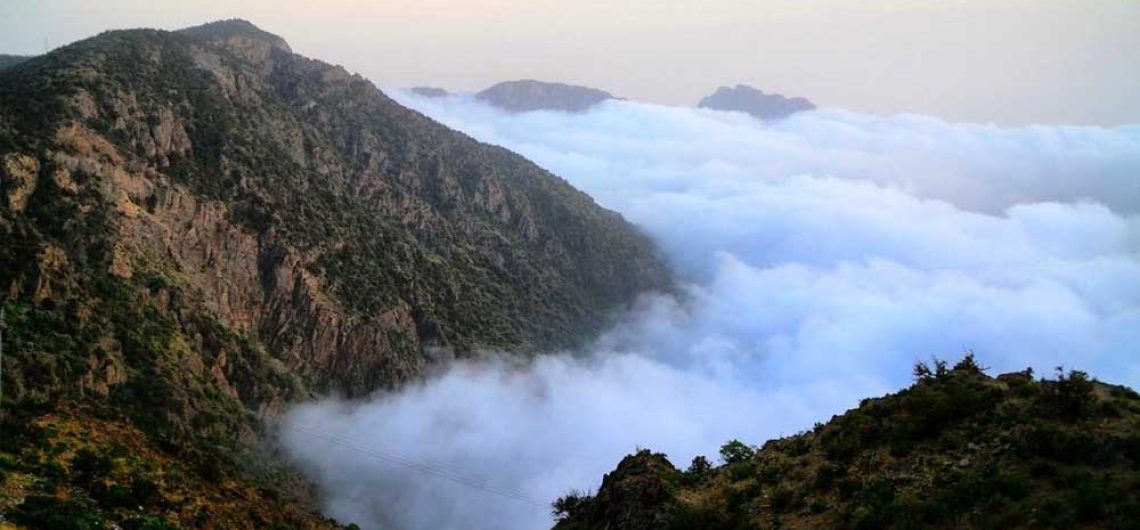Saudi Arabia is home to several majestic mountains, offering stunning landscapes and thrilling outdoor adventures. These mountains, along with several others in Saudi Arabia, provide nature lovers and adventure seekers with an opportunity to explore the country’s natural beauty, experience its rich cultural heritage, and engage in thrilling outdoor pursuits.
The Kingdom of Saudi Arabia is the largest country in the Arabian Peninsula. Its landscape is very varied, with several deserts, plateaus, and sand dunes. The western part of the kingdom is mountainous, with the most well-known of them being the Sarawat Mountains.
The Sarawat Mountains are a chain of mountains in Saudi Arabia and elsewhere in the Arabian Peninsula that were created as a result of a crack in the Red Sea. They range in height from 800 to 3000 meters above sea level and rise as we move south; the highest peak in the chain is Mount Nabi Shuaib, which is in Sana’a, Yemen, from the side of Al Gharbia and is 3666 meters above sea level.
Here are some of the highest mountains in the country:
- Jabal Sawdā’:
With an elevation of 2,995 meters, Jabal Sawdā’ is the highest peak in Saudi Arabia. Located in the Asir Region, it offers breathtaking views and is a popular destination for hikers and nature enthusiasts. - Jabal Manā‘:
Rising to 2,782 meters, Jabal Manā‘ is situated in the Asir Region. It is known for its rugged beauty and provides opportunities for outdoor activities such as hiking and climbing. - Jabal Dakah:
With an elevation of 2,585 meters, Jabal Dakah is located in the Mecca Region. It offers scenic views and is surrounded by stunning landscapes, making it an attractive destination for adventure seekers. - Jabal al Lawz:
Standing at 2,580 meters, Jabal al Lawz is situated in the Tabuk Region. It is known for its unique rock formations and is of historical significance, as it is believed by some to be the mountain where Moses received the Ten Commandments. - Jabal Qarnayţ:
Reaching an elevation of 2,495 meters, Jabal Qarnayţ is located in the Mecca Region. It is a majestic mountain with diverse flora and fauna, and it provides a serene environment for outdoor exploration. - Qa‘mat Abū ash Shaykh:
With an elevation of 2,328 meters, Qa‘mat Abū ash Shaykh is a mountain located in Saudi Arabia. It offers panoramic views of the surrounding landscapes and is popular among hikers and nature lovers. - Jabal Maqlā‘:
Rising to 2,326 meters, Jabal Maqlā‘ is situated in the Tabuk Region. It features unique geological formations and is a great destination for outdoor activities such as hiking and rock climbing. - Jabal Raḑwá:
With an elevation of 2,210 meters, Jabal Raḑwá is located in the Medina Region. It holds religious significance as it is believed to be the mountain where the Prophet Muhammad took refuge during the Hijra (migration) to Medina. - Jabal Idqis:
Reaching an elevation of 2,160 meters, Jabal Idqis is situated in the Medina Region. It offers scenic beauty and tranquility, making it a popular spot for nature lovers and outdoor enthusiasts. - Jabal Shadā Āl Zahrān:
Standing at 2,005 meters, Jabal Shadā Āl Zahrān is a mountain located in Saudi Arabia. It provides stunning views and opportunities for outdoor activities, such as hiking and photography.
These mountains in Saudi Arabia offer diverse landscapes, natural beauty, and opportunities for outdoor exploration. Whether it’s hiking, climbing, or simply enjoying the serene surroundings, these mountains provide a unique and memorable experience for visitors.
How much does it cost to climb Kilimanjaro in Saudi Riyal?
Here is the approximate cost of climbing Kilimanjaro in Saudi Riyal (SAR) based on the provided prices in US dollars (USD):
- Marangu route – 6 days starting from USD 1,695. Approximate cost in SAR: 6,356 SAR
- Machame route – 7 days from USD 1,985. Approximate cost in SAR: 7,432 SAR
- Crater Camp route – 9 days from USD 2,895. Approximate cost in SAR: 10,857 SAR
- Rongai route – 7 days from USD 1,885. Approximate cost in SAR: 7,067 SAR
- Lemosho route – 8 days from USD 2,350. Approximate cost in SAR: 8,805 SAR
- Northern Circuit route – 9 days from USD 2,545. Approximate cost in SAR: 9,538 SAR
Please note that the currency conversion rates may vary, and it is recommended to check the current rates before making any financial transactions.
See also
![]()


Comments